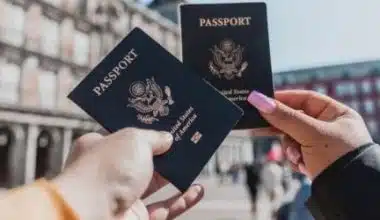Do you wish to apply for a passport for your child and wonder if your partner needs to be present with you? You can discover all you need to know about the application for a child’s passport and if both parents need to be present in this writing. To obtain a child’s passport, both parents must be present during the application process. They must provide proof of U.S. citizenship, evidence of parental relationship, valid photo identification, and parental consent, which can be obtained by completing Form DS-11 and signing it.
Do Both Parents Need To Be Present For the Child’s Passport?
When applying for a child passport, the general requirement is that both parents should appear together and sign the application for the minor under the age of 16. However, there are some exceptions and special circumstances where only one parent needs to be present or additional documentation is required.
To obtain a child’s passport, both parents are generally required to be present during the application process. Here are the requirements for both parents to be present to obtain a child’s passport:
#1. Proof of U.S. Citizenship
To prove your child’s U.S. citizenship, you need an undamaged U.S. passport, a certified birth certificate from the city, county, or state, a Consular Report of Birth Abroad or Certification of Birth, a Naturalization Certificate, and a Certificate of Citizenship.
#2. Evidence of Parental Relationship
To establish a parental relationship with a minor, you must provide either a certified U.S. birth certificate with both parents’ names or a certified foreign birth certificate with both parents’ names.
#3. Photo Identification
Both parents must bring a valid photo identification, such as a driver’s license or passport, to prove their identity.
#4. Parental Consent
Both parents must provide their consent for the child to obtain a passport. This can be done by completing Form DS-11, which is the application form for a U.S. passport, and signing it in the presence of an acceptance agent at a passport acceptance facility.
#5. Passport Photo
You will need to bring a recent passport-sized photo of the child. The photo must meet the specific requirements set by the U.S. Department of State, such as size, background color, and facial expression.
#6. Passport Fees
Payment of the required passport fees is necessary. The cost will vary depending on the child’s age. It is advisable to check the current fee schedule on the official website of the U.S. Department of State or consult with the passport acceptance facility for the exact amount.
#7. Proof of Parental Identity
In addition to photo identification, you may be required to provide additional proof of parental identity. This can include documents such as a driver’s license, state ID card, or military ID card.
#8. Parental Proof of Relationship
If the child’s birth certificate does not list both parents’ names, you may need to provide additional documentation to establish the parental relationship. This can include documents such as a marriage certificate, divorce decree, or court order establishing paternity.
#9. Consent of Both Parents
Both parents must provide their consent for the child to obtain a passport. This can be done by completing Form DS-11 and signing it in the presence of an acceptance agent. If one parent is unable to be present, they may need to provide a notarized statement of consent or a completed Form DS-3053, Statement of Consent, along with a photocopy of their identification.
#10. Presence of Both Parents
It’s important that both parents physically accompany the child during the passport application process. This requirement is in place to ensure that both parents are aware of and agree to the child obtaining a passport.
The Importance of Both Parents Being Present For The Child’s Passport
Both parents being present for a child’s passport application is important for several reasons:
#1. Consent and Acknowledgment
Both parents’ presence ensures that they are aware of and give their consent for the child to obtain a passport. This helps prevent any potential disputes or disagreements regarding the child’s travel plans.
#2. Verification of Identity
When both parents are present, allow the passport acceptance agent to verify the identity of both parents. This helps ensure that the child’s passport application is being processed accurately and that no unauthorized individuals are attempting to obtain a passport for the child.
#3. Prevention of Child Abduction
Requiring both parents to be present is a measure to prevent child abduction. It helps ensure that both parents are involved in the decision-making process and are aware of the child’s travel plans.
#4. Protection of Parental Rights
By requiring both parents to be present, it helps protect the rights of both parents in cases of joint custody or shared parental responsibility. It ensures that both parents have an equal opportunity to participate in decisions regarding the child’s travel.
#5. Verification of Supporting Documents
When both parents are present, it allows the passport acceptance agent to verify the authenticity of the supporting documents, such as the child’s birth certificate and proof of parental relationship. This helps maintain the integrity of the passport application process.
#6. Prevention of Fraud
Requiring both parents to be present helps prevent fraudulent applications for a child’s passport. It ensures that both parents are actively involved in the process and can verify the accuracy of the information provided.
#7. Protection of the Child’s Best Interests
Requiring both parents to be present helps ensure that decisions regarding the child’s passport are made in the child’s best interests. It allows both parents to have a say in the child’s travel plans and helps prevent any potential disputes or disagreements that may arise.
#8. Compliance with Legal Requirements
In some jurisdictions, the law may require both parents to be present for a child’s passport application. This requirement helps ensure compliance with legal regulations and safeguards the rights of both parents.
Requiring both parents to be present helps prevent unauthorized travel of the child. It ensures that both parents are aware of and consent to the child’s travel plans, reducing the risk of abduction or unauthorized removal of the child from the country.
#10. Protection of Parental Rights
Requiring both parents to be present helps protect the rights of both parents, particularly in cases of joint custody or shared parental responsibility. It ensures that both parents have an equal opportunity to participate in decisions regarding the child’s travel.
Circumstances When Only One Parents Being Present For The Child’s Passport
There are exceptions and special circumstances where only one parent needs to be present for a child’s passport application. Here are some of the common exceptions:
#1. Sole Custody
If one parent has sole legal custody of the child, they can apply for the child’s passport without the presence of the other parent. In this case, the parent applying for the passport must provide legal documentation, such as a court order, proving their sole custody.
#2. Absence or Inability of the Other Parent
If the other parent is unable to be present due to various reasons, such as being deceased, incapacitated, or their whereabouts being unknown, the applying parent can provide appropriate documentation to support their claim. This may include a death certificate, medical certificate, or a court order declaring the other parent’s absence or inability to participate in the passport application process.
#3. Notarized Consent
In some cases, if one parent is unable to appear in person, they can provide notarized consent for the child’s passport application. The parent who is present must bring the notarized Form DS-3053, Statement of Consent: Issuance of a Passport to a Minor Under Age 16, along with a photocopy of the front and back of the absent parent’s ID.
#4. Court Order Granting Permission
If there is a court order specifically granting permission for one parent to apply for the child’s passport without the presence of the other parent, then the applying parent can proceed with the application. This court order must explicitly state that the applying parent has the authority to apply for the passport on behalf of the child.
#5. Parental Consent and Notification
In cases where one parent has legal custody of the child and the other parent has limited or no legal rights, the applying parent can provide evidence of this arrangement. This may include a court order or legal agreement that grants sole authority to the applying parent.
#6. Emergencies
In certain emergencies where the child’s well-being or safety is at risk, the applying parent may be allowed to apply for a passport without the presence or consent of the other parent. This typically requires providing evidence or documentation of the emergency, such as a court order, police report, or medical documentation.
#7. Child’s Best Interests
If it can be demonstrated that it is in the child’s best interests to obtain a passport and one parent is unable or unwilling to participate in the application process, the applying parent may be granted an exception. This could include situations where one parent is absent, uninvolved, or has a history of neglect or abuse.
#8. Safety Concerns or Protection Orders
If there are safety concerns or protection orders in place that restrict contact or communication between the parents, the applying parent may be able to apply for the child’s passport without the presence of the other parent. Documentation of the safety concerns or protection orders would need to be provided to support the application.
#9. Parental Consent for International Travel
If one parent has sole authority to make decisions regarding international travel for the child, they may be able to apply for the child’s passport without the presence of the other parent.
#10. Parental Rights Termination
In cases where the parental rights of one parent have been legally terminated, the applying parent may be able to apply for the child’s passport without the presence of the terminated parent.
Requirement When Only One Parent Is Present To Obtain A Child’s Passport
#1. Completed Application Form
The applying parent must complete Form DS-11, which is the application form for a U.S. passport for a minor. This form can be completed in printable or digital format.
#2. Proof of U.S. Citizenship
The applying parent must provide original or certified evidence of the child’s U.S. citizenship. This can include a physical birth certificate, a Consular Report of Birth Abroad (FS-240), or a Certification of Birth Abroad (DS-1350). Photocopies of the citizenship evidence may also be required.
#3. Proof of Parental Relationship
The applying parent must provide documentation that establishes their relationship with the child. This can be done through the child’s birth certificate, adoption decree, or court order.
#4. Identification
The applying parent must present a valid government-issued photo identification, such as a driver’s license or passport.
#5. Passport Photo
A recent color passport photo of the child must be provided. The photo should meet specific requirements, such as size, background color, and appearance.
#6. Fees
The applying parent must pay the required fees for the child’s passport application. The fees can vary depending on the child’s age and whether expedited processing is requested.
What Questions Do You Have to Answer at the Airport?
When traveling at the airport, you may be asked various questions related to your identification and travel documents, flight details, luggage, security screening, customs and immigration, and health and safety. These questions help ensure compliance with regulations, verify your eligibility to enter the country, and maintain security. It’s important to answer truthfully and cooperate with airport staff and officials. Specific questions can vary depending on the airport, country, and individual circumstances.
At What Age Does a Child Need a Passport?
A child needs a passport regardless of age when traveling internationally by air. All passengers, including infants and children, must have a valid passport when traveling to a foreign country by air. This requirement applies to U.S. citizens and citizens of other countries. However, when traveling within the continental United States, a passport is not required for children.
How Quickly Can I Get a Passport?
The processing time to obtain a passport can vary depending on factors such as the country and the type of service chosen. Standard processing times typically range from 7–10 weeks, while expedited processing can take 3-5 weeks. Urgent or emergency passport services are available for immediate travel plans within 14 days.
What Is the Difference Between a Passport Book and a Passport?
The main difference between a passport book and a passport card is their appearance and the methods of travel for which they are eligible. A passport book is the traditional and most common form of a passport, accepted for all forms of international travel, including air, sea, and land travel. On the other hand, a passport card is a smaller, wallet-sized card primarily intended for land and sea travel between the United States and specific regions, such as Mexico, Canada, the Caribbean, and Bermuda. Passport cards cannot be used for air travel to foreign destinations and have more limited acceptance worldwide.
What Do You Need for a Child’s Passport?
To apply for a child’s passport, you need proof of citizenship, evidence of parental relationship, valid photo identification, parental consent, a recent passport photo, and passport fees. The requirements may vary depending on the child’s age and the service requested. Both parents or guardians must appear in person with the child if listed on the birth certificate.
How Do I Write a Letter of Consent for a Child’s Passport?
When writing a letter of consent for a child’s passport, there are no official guidelines for its content and format. However, the letter typically includes information such as the child’s details, parent/guardian information, accompanying person, and travel details. It’s important to note that sample letters and interactive forms can be found online, and consulting a lawyer may be helpful. It’s also recommended to check the specific requirements of the passport-issuing authority.
Conclusion
Both parents are crucial for a child’s passport application, as it ensures compliance with legal requirements. This ensures equal participation in decision-making, protection of parental rights, and compliance with legal regulations, thereby preventing potential disputes and ensuring a smooth process. In certain circumstances, only one parent is required for a child’s passport application. When only one parent is present to obtain a child’s passport, the applying parent must complete the application form and provide the necessary information.
- US PASSPORT VISA FREE COUNTRIES IN 2024
- WHEN DOES A PASSPORT EXPIRE? All You Need To Know
- DO YOU NEED A PASSPORT TO GO TO BAHAMAS CRUISE?
- HOW LONG IS A US PASSPORT GOOD FOR?
- HOW LONG DO PASSPORTS LAST?






